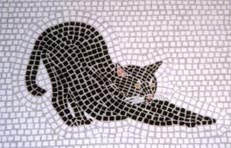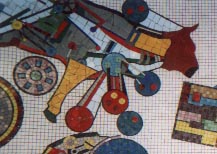As well as the choice of materials, colours and design, a number of extra factors affect the overall appearance of a mosaic:
- the size and shapes of the pieces
- the size of the interstices (the gaps or "grouting joints" between pieces)
- the colour of the grout
On top of this, the way the pieces and grouting joints are aligned can be used to give a visual "flow" to the mosaic. This flow is called "andamento" and can be used in a number of ways and combinations of techniques. These have different names to describe the kind of work ("opus") involved. (There is sometimes some overlap in the way these terms are used.)

opus vermiculatum
This takes its name from the Latin for 'worm'. It refers to lines of tesserae that snake around a feature in the mosaic. Often two or three rows of opus vermiculatum appear like a halo around something in a mosaic picture, helping it stand out from the background.

opus musivicum
This is an effect rather like ripples on a pond, with repeated rows of tesserae which spread out to fill a background, as in the background to this fish tile.
opus palladinium
A "crazy pavement" effect, with a random appearance.
opus sectile
This is a technique where, instead of being made up of lots of individual tesserae, shapes in a picture are made from larger, specially cut, pieces (perhaps of tile or stone). more about opus sectile

opus regulatum
As the name suggests, this is a very regular pattern,
like bricks in a wall, or squares on a chess board. The example on the left shows a background to a mosaic in Tottenham Court Road tube station in London.


